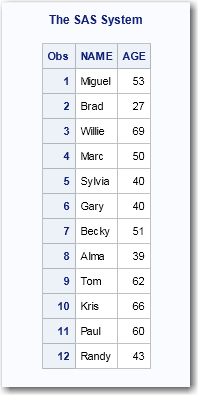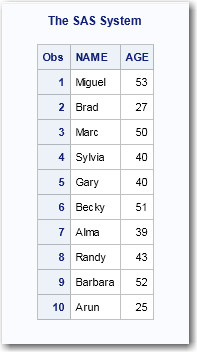OBS= Data Set Option
Specifies the last row in a data source that SAS
processes.
| Valid in: | DATA and PROC steps |
| Category: | Observation Control |
| Default: | MAX |
| Restriction: | Use with input files only |
| Supports: | All |
Syntax
OBS= n | nK
| nM | nG
| nT | hexX
| MIN | MAX
Syntax Description
- n | nK | nM | nG | nT
-
specifies a number to indicate when to stop processing rows, with n being an integer. Using one of the letter notations results in multiplying the integer by a specific value. That is, specifying K (kilobytes) multiplies the integer by 1,024, M (megabytes) multiplies by 1,048,576, G (gigabytes) multiplies by 1,073,741,824, or T (terabytes) multiplies by 1,099,511,627,776. For example, a value of
20specifies 20 rows, whereas a value of3mspecifies 3,145,728 rows.
- hexX
-
specifies a number to indicate when to stop processing as a hexadecimal value. You must specify the value beginning with a number (0–9), followed by an X. For example, the hexadecimal value F8 must be specified as
0F8xin order to specify the decimal equivalent of 248. The value2dxspecifies the decimal equivalent of 45.
- MIN
-
sets the number to indicate when to stop processing to 0. Use OBS=0 in order to create an empty data set that has the structure, but not the rows, of another data set.Interaction:If OBS=0 and the NOREPLACE option is in effect, then SAS can still take certain actions because it actually executes each DATA and PROC step in the program, using no rows. For example, SAS executes procedures, such as CONTENTS and DATASETS, that process libraries or SAS data sets.
Details
OBS= tells SAS when
to stop processing rows. For example, if OBS=10 is specified, the
result is ten rows or records.
In WHERE processing,
SAS first subsets the data, and then applies OBS= to the subset. The
FEDSVR engine does not have the concept of observation numbering from
the original data set. It sends back the number of rows requested,
numbered chronologically, regardless of where they occur in the data
set.
Examples
Example 1: Using OBS= to Specify When to Stop Processing Rows
This example illustrates
the result of using OBS= to tell SAS when to stop processing rows.
This example creates a SAS data set that contains 15 rows, and then
executes the PRINT procedure with OBS=12. The result is 12 rows.
Example 2: Using OBS= with WHERE Processing
This example illustrates
the result of using OBS= along with WHERE processing. The example
uses the data set that was created in Example 1, which contains 15
rows, and assumes that the SAS session has been reset to the defaults
FIRSTOBS=1 and OBS=MAX. This example returns the first 10 rows that
meet the WHERE criteria.

